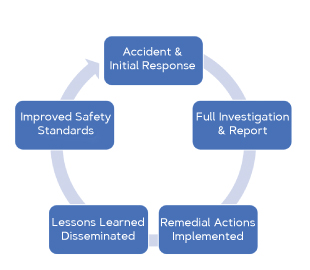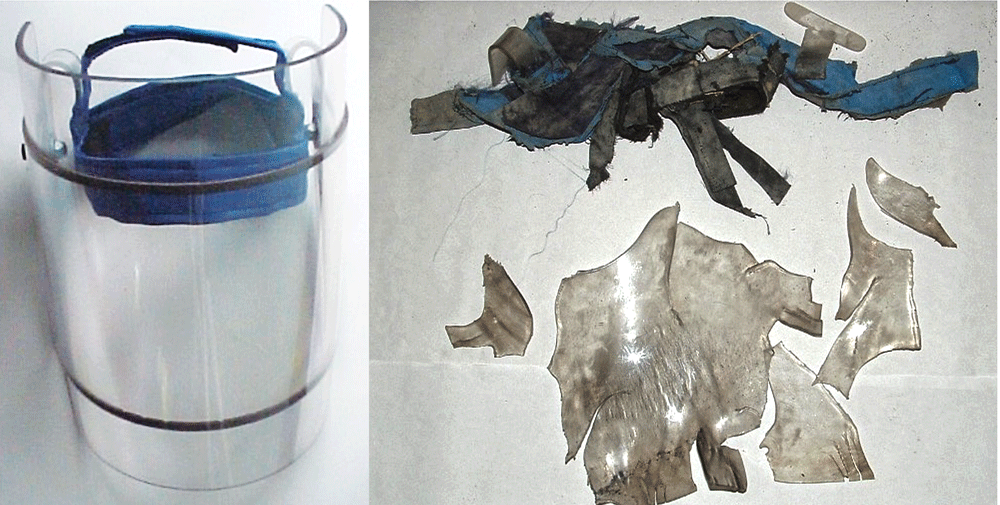Accident Response to Mitigate Risk:
A Call to Action
CISR JournalThis article is brought to you by the Center for International Stabilization and Recovery (CISR) from issue 25.2 of The Journal of Conventional Weapons Destruction available on the JMU Scholarly Commons and Issuu.com.
By Lillian Gates[ Office of Weapons Removal and Abatement, Bureau of Political-Military Affairs,
U.S. Department of State ]
Effective accident response in humanitarian mine action (HMA) contributes to increased safety in future demining work. Mine action organizations play a variety of roles in the improvement of accident response, with the U.S. Department of State’s Office of Weapons Removal and Abatement in the Bureau of Political-Military Affairs (PM/WRA) being the most recent to adjust their accident response process by establishing the Accident Review Panel (ARP). This panel consolidates the office’s efforts and allows for standardized accident response protocol and the collection and analysis of accident data. Other organizations active in cultivating better accident responses include the United Nations Mine Action Service (UNMAS), The HALO Trust (HALO), Geneva International Centre for Humanitarian Demining (GICHD), private accident specialists such as Andy Smith and his Database of Demining Accidents (DDAS), and other mine action actors. Accident response continues to improve as organizations focus on best practices such as accident preparedness, conducting quality investigations and reports, and promoting a culture of openness when sharing lessons learned. Through continuous dedication to best practices in accident response, the HMA community may see improved safety in future projects and demining endeavors.
Although members of the HMA community employ an array of safety protocols to mitigate risk, the unfortunate reality is that accidents happen. Effective accident response is key to learning from mistakes and enhancing the safety of future demining projects. PM/WRA recently launched an initiative designed to take steps towards improved accident management. The newly established ARP will standardize PM/WRA’s response to accidents happening within the office’s grant-funded projects, as well as enable the office to store and track trends in accident data over time. This approach is one of many ways that the HMA community is responding to accidents. Accident response continues to improve, especially with a greater focus on preparedness, quality investigations and response, and the promotion of a culture of openness. This technical report surveys the current state of accident reporting and concludes with potential best practices and improvements for future accident management.
IMAS
One of the most well-known guides for accident response is the International Mine Action Standards (IMAS). IMAS 10.60 was first published in 2001 and has most recently been updated in the 2020 revised second edition titled, “Safety & occupational health – Investigation and reporting of accidents and incidents.”1 The IMAS Review Board—under the leadership of UNMAS, with secretariat support from the GICHD and comprised of over twenty national representatives, nongovernmental organizations (NGOs), and other entities—must reach consensus among the many stakeholder perspectives. As a result, the standards reflect a baseline level of compliance but provide a plethora of elective recommendations for ideal accident response. Most members of the HMA community follow IMAS guidance and recommendations.
This newest iteration of IMAS 10.60 streamlines the post-accident process into two stages: an immediate report completed within twenty-four hours of the accident or incident, followed by a detailed investigation and final report completed as quickly as possible. The revised second edition also places a heavy emphasis on gathering evidence through interviews, physical examination, etc., as well as conducting investigations that are “clear, comprehensive, evidence-based, and timely” to “reduce the likelihood of harm to the lowest practicable level.”2 During the reporting process, investigators are encouraged to conduct a causal analysis to identify potential causes of accidents that could inform remedial actions. IMAS 10.60 also promotes unbiased investigating/reporting and suggests practices of peer review, extensive evidence gathering, and detailed recordkeeping throughout the entire accident reporting process.3 These standards provide guidance for how accident responses should be conducted and set the precedent for many in the HMA community.
The Department of State
In 2021, PM/WRA introduced the ARP as a new method for accident reporting management. Before the ARP was established, accidents occurring within U.S.-funded projects were managed by PM/WRA’s respective grant officers and program managers. The implementing partners would notify the office of accidents and submit a formal report on the event. In contrast to the now centralized system, individual grant officers would maintain jurisdiction over the accident reports and remedial actions deemed appropriate for each situation. ARP chair Michael Tirre, a program manager in PM/WRA, expressed that this traditional “one-off” process made it difficult to ensure a standardized approach to cataloging and responding to accidents on U.S.-funded awards. It also limited PM/WRA’s ability to identify trends over time.

Figure 1. Cycle of accident response and improved safety. Figure courtesy of the author/Johns Hopkins University.
In 2020, PM/WRA received an unusually high number of demining accident reports, underscoring the importance of addressing accidents in the field. Responding to this concern, in 2020 the office established the Safety and Accountability Working Group to improve safety with implementing partners. The working group identified the need for a more permanent and standardized response to accidents. As a result, the ARP was established in the spring/summer of 2021 as a standing panel ready to convene in response to accident reports. Tirre explained that the panel seeks to better report and respond to accidents as well as identify trends that can inform future demining practices. Comprised of ten members, the panel will grow to include grant officers and volunteers from PM/WRA’s regional teams, and ultimately may include representatives from partner U.S. government agency offices.4
A new protocol for reviewing and responding to accident reports was delineated as well. When an accident report is submitted, the panel will convene, evaluate, and decide on a response. The evaluation phase begins with an assessment of the information presented to determine if it is sufficiently detailed. The panel will then decide if the terms and conditions of the grant were violated during the accident. After identifying any terms and conditions violated, an analysis will assess if the proposed remedial actions are adequate to prevent recurrence.
If insufficient, the panel can draft suggestions for the implementing organization.
The ARP has been established to emphasize the United States’ commitment to the safety of all demining personnel on U.S.-funded projects. To ensure an environment of openness, Tirre emphasized that the panel’s goal is not to carry out punishments or conduct independent PM/WRA investigations of incidents, but to promote a culture of safety and cooperation. Should remedial action be necessary, the panel can suggest potential corrective actions to the grant manager. The ARP will also contribute to international mine action literature. Tirre stated that the ARP will consolidate cases the panel reviews and potentially could share general information on any trends observed with the greater mine action community that could contribute to more effective preventative training and education for deminers, and ultimately fewer accidents.5
The HALO Trust
HALO has a well-developed accident response protocol. Project teams run accident casualty drills monthly in preparation for a potential accident. When an accident occurs, project managers in the field handle immediate triage including sending any victims to the hospital and notifying headquarters. Other projects in that country are often paused to avoid the risk of two accidents happening simultaneously, especially if the initial accident is due to a process error. Once the initial response is complete, project managers are responsible for collecting evidence and interviewing individuals involved as soon as possible to gain the most accurate information about the event. Internal investigations are then carried out alongside the national authority’s investigations. If there is no national authority represented, a third-party investigation team may be organized and include HALO employees from other projects/headquarters, accident specialists, and representatives from other demining NGOs. These investigation teams aim to include both unbiased representatives and those familiar with HALO procedures. Once investigations are complete—this process may take a few days to a few months depending on the availability of investigation teams—the report is reviewed, and remedial actions are enacted. Adam Jasinski, Director of Capability at HALO, emphasized that the most important part of the accident response process is implementing and following up on modifications recommended by the investigation, and that organizations should never assume the changes will happen smoothly. If the investigations reveal issues that go beyond organization-specific protocols, HALO will voluntarily share the reports with national authorities and other NGOs. This openness in the HMA community is reciprocated by other NGOs.

Before and after images of a visor involved in an accident in Tajikistan. Images courtesy of Andy Smith/DDAS/CISR.
Institutions and Specialists
The GICHD provides resources for accident response as part of its mission to “develop and professionalise the sector” to reduce risk. GICHD-written articles published in this Journal report on best practices for reducing risk in various demining situations.6 The organization also provides professional training courses including the “Accident Investigation Course,” which teaches field staff the fundamentals of accident investigation.7 In an effort to inspire changes in work practice and improve demining equipment, GICHD launched the MACRA database: an online central repository of accidents, incidents, and near misses.8 Input to this database is provided by members of the GICHD Central Repository Working Group comprised of representatives from various HMA organizations. Data is categorized according to location of the incident, injury, explosive ordnance type, etc., without disclosing sensitive information such as names of persons involved. To date, MACRA contains over 1,500 accident reports.9
The DDAS is an independent accident report database of over 800 accident reports collected and made available by Andy Smith, a humanitarian mine action specialist who has worked for governments, the United Nations, NGOs, and commercial organizations at all levels.10 He served for ten years on the IMAS Review Board as an independent specialist on personal protective equipment (PPE) and injury prevention. Smith takes care to analyze the accident reports gathered by/submitted to him and incorporate them into trainings and consultations he provides to the HMA community. The DDAS is now housed in the Humanitarian Demining Accident and Incident Database (AID) in the Global Conventional Weapons Destruction (CWD) Repository managed by the Center for International Stabilization and Recovery (CISR).11 CISR contributes to improving accident responses by also publishing relevant articles in The Journal of Conventional Weapons Destruction (JCWD), such as issue 24.2, which featured Roly Evans’ “Notes on the Revised Second Edition” of IMAS 10.60.12 These actors provide the HMA community with resources that can improve safety through high-quality accident management.
Best Practices and Potential Improvements
Conversations with members of the HMA sector indicate that the community is dedicated to promoting safety through high-quality accident response. A few common themes emerge as potential best practices going forward: preparedness, quality investigations and response, and cultivating a culture of openness. These best practices may be relevant as the HMA community seeks to continue improving safety through accident response.
Preparedness. Being prepared can be one of the most important steps in effective accident response management. Preparedness begins with training field staff in proper safety techniques and enforcing these practices regularly. HALO’s regular accident training sets a good example to follow. Staff may also benefit from programs such as GICHD’s Accident Investigation Course that trains staff in proper accident response including immediate damage control, how to collect evidence and testimonies from witnesses, and how to carry out investigations and write reports if an investigation team is not available. If/when an accident does occur, prescribing and enforcing remedial actions could prepare field staff to avoid similar accidents in the future, as emphasized by Adam Jaskinski of HALO.
Quality Investigations and Response. The quality of an accident investigation can affect the accuracy and effectiveness of prescribed remedial actions. IMAS 10.60 stresses the importance of evidence-based investigations, suggesting that improvements in evidence gathering could significantly improve investigations and reports. These investigations may also benefit from multiple perspectives on a situation and newly adopted technology like LiDAR and unmanned aerial systems (UAS). Through neutral and/or diverse investigation teams, investigations can overcome cognitive bias, a phenomenon where individual perspectives are limited by unintentional bias. Once evidence is gathered, Andy Smith emphasized the importance of asking “why” an accident occurred and anticipating that there may be multiple reasons. This causal analysis can provide insights into which remedial actions could be most helpful in preventing similar accidents in the future. Once these remedial actions are implemented, Jasinski’s advice is to expect the changes to take time and require regular enforcement.
Culture of Openness. Emphasizing a culture of openness may result in a safer HMA community. Members of the HMA community are in general agreement that subpar accident reporting is not the result of intentionally devaluing safety. Instead, the quality of reports may decline as other values such as fear of retribution take precedence over safety. At the individual level, prioritizing safety may encourage field staff to report accidents and near misses in detail rather than keeping quiet for fear of retribution. This would allow for greater detail in evidence gathering and ultimately more accurate investigations and reports. In an environment where safety takes precedence over competition, organizations can prioritize operational risk management over organizational risk management by engaging in honest reporting and the sharing of lessons learned publicly. National actors and donors are also able to promote openness by encouraging safe practices and effective reporting through legislation and grant contracts. Encouraging a culture of openness may also improve the information available publicly about accident trends over time. Looking to the future, increased use of databases like the MACRA and the AID/DDAS could enable unbiased analysis of accident trends and provide the HMA community with greater understanding of the causes of accidents and how to avoid them.
Call to Action
In its commitment to enhancing safety, the HMA community recognizes the importance of effective accident response. While risk will never be completely eradicated, continually improving accident investigations and reporting can improve safety in the field. PM/WRA’s ARP is the latest example of how the HMA community is dedicating more resources to this critical need. Broad and sustained commitment to preparedness, quality investigations and reporting, and a culture of openness is key to reducing accidents and enhancing safety going forward. ◊
Lillian Gates
Office of Weapons Removal
and Abatement, Bureau of Political Military Affairs,
U.S. Department of State
 Lillian Gates is a Frasure-Kruzel-Drew Memorial Fellow at the U.S. Department of State’s Office of Weapons Removal and Abatement in the Bureau of Political-Military Affairs (PM/WRA). Gates graduated in 2021 with a Master of Arts in Political Science from James Madison University.
Lillian Gates is a Frasure-Kruzel-Drew Memorial Fellow at the U.S. Department of State’s Office of Weapons Removal and Abatement in the Bureau of Political-Military Affairs (PM/WRA). Gates graduated in 2021 with a Master of Arts in Political Science from James Madison University.

